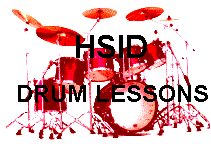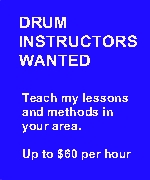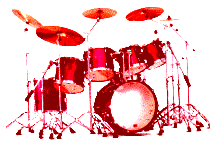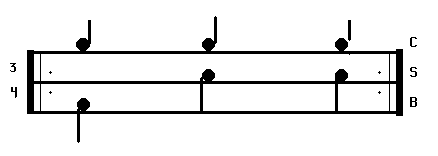 

Lesson Menu #2
Intermediate & Advanced.
Lesson Menu #3
Advanced & Ultra-Advanced.
Lesson Menu #4
Text lessons: All levels.

PRODUCTS:

GET ALL THE PRODUCTS AT ONE LOW PRICE.

SURPRISES ABOUND . . . For those with a bit of generosity
in their soul.
CLICK HERE , to see what I mean.

Intermediate & Advanced
Drummers
 Your future is waiting.
Your future is waiting.

ALL MUSICIANS
MASTER
ALL RHYTHM,
This FASCINATING WAY!
 Discover the 'LOST KEY' for Unraveling
ALL the mysteries of rhythm, and musical time.
Discover the 'LOST KEY' for Unraveling
ALL the mysteries of rhythm, and musical time.
This work
is the crowning-achievement of my 50 year career, and it's
my proudest accomplishment.
It contains the potential to help YOU change the face of modern music!
You'll love it! CLICK HERE to check it
out completely! You're in for a MAJOR surprise!
 "PRE-SCHOOL DRUMMER?
"PRE-SCHOOL DRUMMER?
YES!"
Can we teach rhythm
to pre-schoolers? YES!

This is a very short course,
designed to help adults plant the seeds of rhythm
into children of nearly any age.
CLICK HERE
 FREE ELECTRONIC BOOK BONUS (also included)
FREE ELECTRONIC BOOK BONUS (also included)
 BUSINESS OPPORTUNITY:
BUSINESS OPPORTUNITY:
MAKE BIG MONEY SELLING USED DRUMSETS!
* INSIDER HARDBALL-BUYING-TIPS AND SECRETS.
* UNIQUE RECOVERING SECRETS

Support this site and and gain an advetising bargain with the deal.
 Place a permanent ad here. Place a permanent ad here.

GET ALL THE PRODUCTS AT ONE LOW PRICE.

SURPRISES ABOUND . . . For those with a bit of generosity
in their soul.
CLICK HERE , to see what I mean.

|
|
Downloads *
Drummers Trivia *
Drummers Chat Rooms *
Rudiments *
Digital Music *
Knowledge Assessments *
TD Archives *
Drum Set Buyers Guide *
Bass-Player Jokes *
Assembling a Drum Set *
Parts of a Drum Set *
About HSID *
Video Troubleshooter
Bill Powelson's School of Drums
School of Drums
Waltz

What is a Waltz?
The Waltz beat gets its name from a dance, based on three steps and a three-count measure. According to Webster, the term originated from Old High German walzan, meaning to turn or roll. It first appeared in 1781. The dictionaries and encyclopedias all seem to insinuate 3/4 time only. We will see in a moment that many variations of the Waltz dance beat may be written in any number of interesting time signatures. We will begin with the slower rhythms and move up to the quick tempo beats.
NOTICE: When it seems that musical symbols (rests) may confuse beginning students, I will avoid using them.
16th note 3/4 Waltz: This rhythm hasn't really had its day in the sun. You will not hear many songs that use it. I say it is waiting for the right song or songs. After studying Permutation theory you will be able to visualize at least 16,777,216 variation possibilities with this solitary form of Waltz. How many songs are you familiar with that use it? Go get 'em, songwriters!
 Hear the Basic 16th WALTZ Beat Hear the Basic 16th WALTZ Beat
 VIDEO: Click here to 'Play', see, and hear the above 16th Waltz, video. VIDEO: Click here to 'Play', see, and hear the above 16th Waltz, video.
8th triplet 3/4 Waltz or 9/8 Waltz: This has become a very popular form of Waltz. You will hear this pattern used often in top 40, contemporary and country & western music styles. When played at a comfortable tempo, it can take some drudgery away from playing the really boring songs. This beat contains 262,144 variations, not including syncopations. We need not write it exclusively in 3/4 time. I am showing two examples below, to help illustrate that point.
8th triplet 3/4 Waltz: 
 Hear the Basic 8TH TRIPLET WALTZ Beat Hear the Basic 8TH TRIPLET WALTZ Beat
The 9/8 version possesses the same number of permutations and is played the same. It is the same beat pattern and we could write it several other ways as well. 
8th note 3/4 Waltz: This modification of 3/4 time may not seem especially exciting at first but with practice you will discover that it is a close cousin to the ever popular 8th 4/4 'rock' beat that has dominated the music scene for so many years. You will also quickly discover that it has inherited much of the same 'funk' potential as cousin 'rocko'. After you gain a feel for 8th 3/4 you will find yourself jamming with variations, syncopations and fills on a new level. From that point, all you will need is a band that is innovative enough to create lyrics and music to fit the beat. We may squeeze up to 160,000 syncopated variations from this pattern.
  Hear the Basic 8th WALTZ Beat Hear the Basic 8th WALTZ Beat
 VIDEO: Click here to 'Play', see, and hear the above 8th (Rock?) Waltz, video. VIDEO: Click here to 'Play', see, and hear the above 8th (Rock?) Waltz, video.
If you want something a little tougher, try the syncopated variation below. Also, experiment with a few similar examples of your own.
  Hear the Syncopated WALTZ Beat Hear the Syncopated WALTZ Beat
 VIDEO: Click here to 'Play', see, and hear the above Syncopated Waltz, video. VIDEO: Click here to 'Play', see, and hear the above Syncopated Waltz, video.
Shuffle 3/4 Waltz:
There are 8th rests in this one that we can't live without. Count:"1 an a 2 an a 3 an a". Do not strike the cymbal as you say "an". Like Swing/Shuffle 4/4 it may take a while to get this one perfect. Don't worry about it if you are having trouble. Sometimes it will require just the right song before it will feel natural. Polish will come with time and experience, so be patient. Shuffle Waltzes are more prevalent in Country & Western music styles. We may write this pattern several ways, including triplet 3/4 or 9/8. Theoretically it exists with the same number of variation possibilities as the two above.
 Hear the Basic SHUFFLE WALTZ Beat Hear the Basic SHUFFLE WALTZ Beat
 VIDEO: Click here to 'Play', see, and hear the above Shuffle Waltz, video. VIDEO: Click here to 'Play', see, and hear the above Shuffle Waltz, video.
Quarter note 3/4 Waltz: Quarter note Waltz is most often used with fast waltz tunes. It is easy to play but a bit of a bore!  Hear the Basic 4th WALTZ Beat Hear the Basic 4th WALTZ Beat
 VIDEO: Click here to 'Play', see, and hear the above Quarter-note Waltz, video. VIDEO: Click here to 'Play', see, and hear the above Quarter-note Waltz, video.
Here is an additional lesson on the Waltz Beat. It goes into
more detail about the many (5 quintillion) ways it can be varied.
There is still much more . . . Yes, I am afraid there is a whole lot more but then it may be two or three centuries before any of it will be of any practical use. For example, if you are up on your note values. Some modifications I have excluded are:
- 16th triplet 3/4 contains a whopping 6.87 billion permutations.
- 32nd 3/4 contains 2.81474977e+14 variations. This pattern contains some interesting 'disco' possibilities too. By 'disco' I am referring to playing a two handed roll on the hi-hat while slipping to the snare on the counts of 2 and 3.
- 64th 3/4. . . .forget it!
RUDIMENTS, ROLLS and FILLS (Part 1): Boring rolls are not so boring when used as thundering fill patterns in mid-song. (Simplified for beginners!)

 Copyright Bill Powelson 1994 all rights reserved.
Copyright Bill Powelson 1994 all rights reserved.
| |



